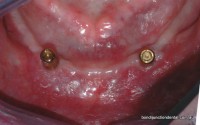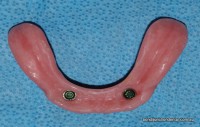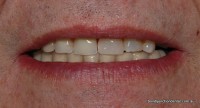Stud Retained Over Denture
Implants – Stud Retained Over-Denture
Only two or three implants are used to stabilise an over-denture.
Two or three implant fixtures may be placed towards the front the jaw with press stud type attachments or special clips to hold a denture.
This treatment option is much less complex and greatly reduces costs. This treatment option is suitable where it is not possible to place multiple implants in the jaw due to insufficient bone or if a patients wants to limit their costs.
The over-denture rests on both the gum and the implants.
The over-denture is designed so that the chewing load is distributed onto both the gum and onto the implant.
Advantages:
Over-dentures are considerably more stable.
Some patients even have difficulty removing their over-dentures and often softer nylon retention clips are used.
Patients have less or no sore spots as implant retained over-dentures do not move about or dislodge like full or part dentures.
Patients gain in confidence and in chewing power.
It may even be possible to modify an existing denture to accept the implant clips which further reduces costs.
Cleaning both the over dentures and implants are easy.
Repairs and maintenance are easy.
Disadvantages:
There is only some very minor downward movement of the over-denture onto the gum at the back of the mouth as the limited number of implants at the front of the mouth are not designed to take all the biting load.
There is no movement at the front of the mouth over the implants.

After: two implants with press stud type attachments that clip into under-surface of a full lower denture

Under-surface of denture showing stud attachments

Patient wearing a lower denture with marked increase in retention